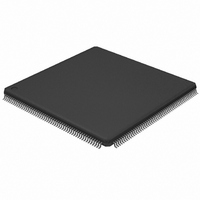LPC2420FBD208,551 NXP Semiconductors, LPC2420FBD208,551 Datasheet - Page 45

LPC2420FBD208,551
Manufacturer Part Number
LPC2420FBD208,551
Description
IC ARM7 MCU ROMLESS 208LQFP
Manufacturer
NXP Semiconductors
Series
LPC2400r
Datasheet
1.LPC2460FBD208551.pdf
(79 pages)
Specifications of LPC2420FBD208,551
Program Memory Type
ROMless
Package / Case
208-LQFP
Core Processor
ARM7
Core Size
16/32-Bit
Speed
72MHz
Connectivity
EBI/EMI, I²C, Microwire, MMC, SPI, SSI, SSP, UART/USART, USB OTG
Peripherals
Brown-out Detect/Reset, DMA, I²S, POR, PWM, WDT
Number Of I /o
160
Ram Size
82K x 8
Voltage - Supply (vcc/vdd)
3 V ~ 3.6 V
Data Converters
A/D 8x10b; D/A 1x10b
Oscillator Type
Internal
Operating Temperature
-40°C ~ 85°C
Processor Series
LPC24
Core
ARM7TDMI-S
Data Bus Width
16 bit, 32 bit
Data Ram Size
82 KB
Interface Type
CAN/I2C/I2S/SPI/SSP/UART/USB
Maximum Clock Frequency
72 MHz
Number Of Programmable I/os
160
Number Of Timers
4
Operating Supply Voltage
3.3 V
Maximum Operating Temperature
+ 85 C
Mounting Style
SMD/SMT
3rd Party Development Tools
MDK-ARM, RL-ARM, ULINK2
Minimum Operating Temperature
- 40 C
On-chip Adc
8-ch x 10-bit
On-chip Dac
1-ch x 10-bit
Lead Free Status / RoHS Status
Lead free / RoHS Compliant
Eeprom Size
-
Program Memory Size
-
Lead Free Status / Rohs Status
Lead free / RoHS Compliant
Other names
568-4527
935286745551
935286745551
Available stocks
Company
Part Number
Manufacturer
Quantity
Price
Company:
Part Number:
LPC2420FBD208,551
Manufacturer:
NXP Semiconductors
Quantity:
10 000
NXP Semiconductors
LPC2420_60_5
Preliminary data sheet
7.25.4 AHB
7.25.5 External interrupt inputs
7.25.6 Memory mapping control
7.26.1 EmbeddedICE
7.26 Emulation and debugging
The LPC2460 implements two AHB in order to allow the Ethernet block to operate without
interference caused by other system activity. The primary AHB, referred to as AHB1, is
implemented on LPC2420 as well and includes the Vectored Interrupt Controller, GPDMA
controller, USB interface, and 16 kB SRAM.
The second AHB, referred to as AHB2, is implemented on LPC2460 only and includes
only the Ethernet block and an associated 16 kB SRAM. In addition, a bus bridge is
provided that allows the secondary AHB to be a bus master on AHB1, allowing expansion
of Ethernet buffer space into off-chip memory or unused space in memory residing on
AHB1.
In summary, bus masters with access to AHB1 are the ARM7 itself, the USB block, the
GPDMA function, and the Ethernet block (via the bus bridge from AHB2). Bus masters
with access to AHB2 are the ARM7 and the Ethernet block.
The LPC2420/2460 includes up to 68 edge sensitive interrupt inputs combined with up to
four level sensitive external interrupt inputs as selectable pin functions. The external
interrupt inputs can optionally be used to wake up the processor from Power-down mode.
The memory mapping control alters the mapping of the interrupt vectors that appear at the
beginning at address 0x0000 0000. Vectors may be mapped to the bottom of the Boot
ROM, the SRAM, or external memory. This allows code running in different memory
spaces to have control of the interrupts.
The LPC2420/2460 support emulation and debugging via a JTAG serial port. A trace port
allows tracing program execution. Debugging and trace functions are multiplexed only
with GPIOs on P2[0] to P2[9]. This means that all communication, timer, and interface
peripherals residing on other pins are available during the development and debugging
phase as they are when the application is run in the embedded system itself.
The EmbeddedICE logic provides on-chip debug support. The debugging of the target
system requires a host computer running the debugger software and an EmbeddedICE
protocol convertor. The EmbeddedICE protocol convertor converts the Remote Debug
Protocol commands to the JTAG data needed to access the ARM7TDMI-S core present
on the target system.
The ARM core has a Debug Communication Channel (DCC) function built-in. The DCC
allows a program running on the target to communicate with the host debugger or another
separate host without stopping the program flow or even entering the debug state. The
DCC is accessed as a coprocessor 14 by the program running on the ARM7TDMI-S core.
The DCC allows the JTAG port to be used for sending and receiving data without affecting
the normal program flow. The DCC data and control registers are mapped in to addresses
in the EmbeddedICE logic.
Rev. 05 — 24 February 2010
Flashless 16-bit/32-bit microcontroller
LPC2420/2460
© NXP B.V. 2010. All rights reserved.
45 of 79















